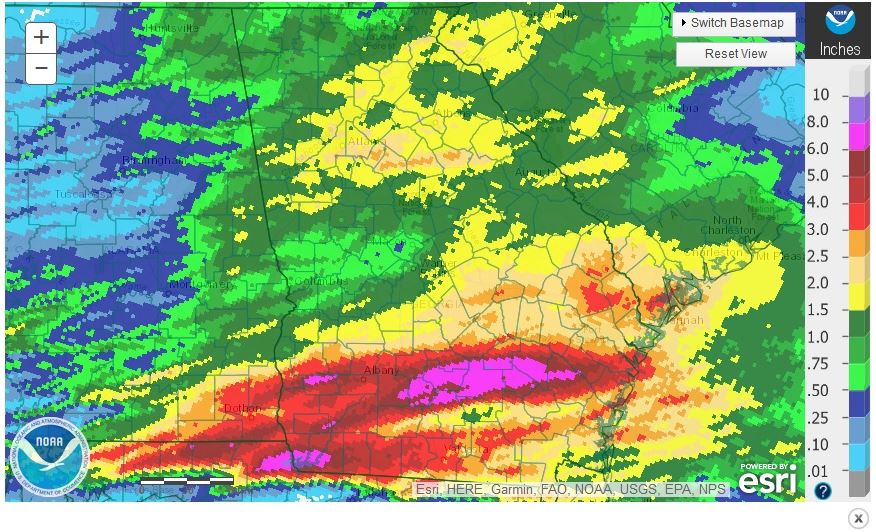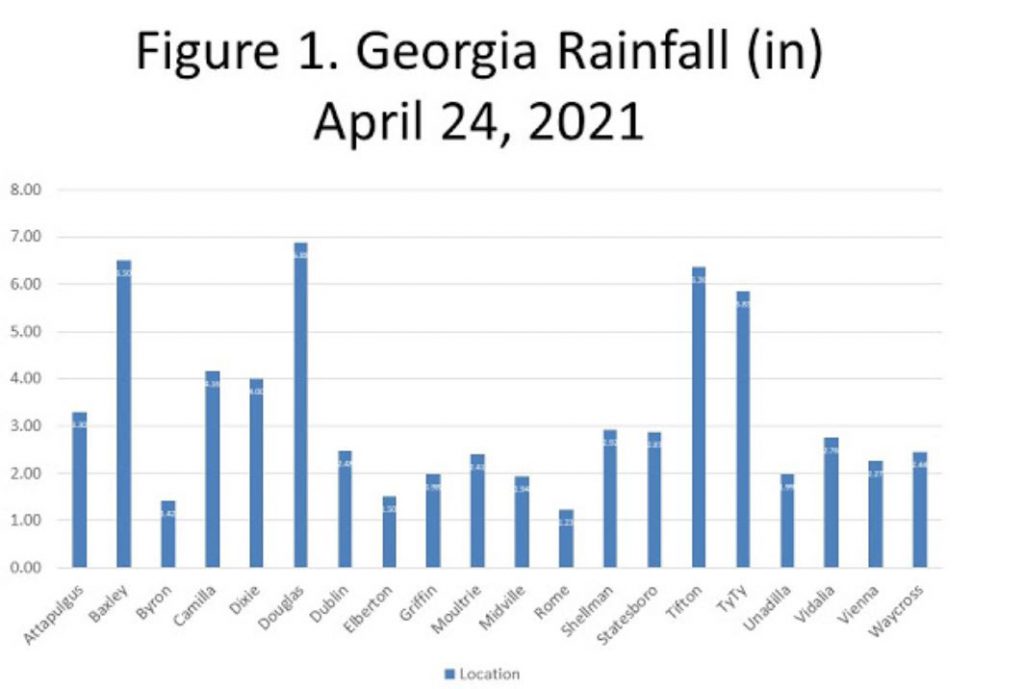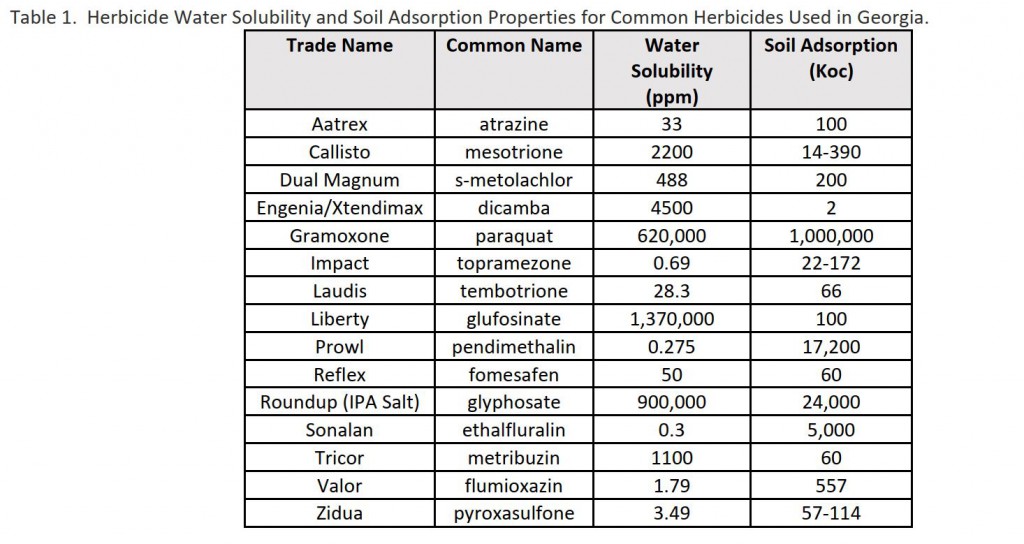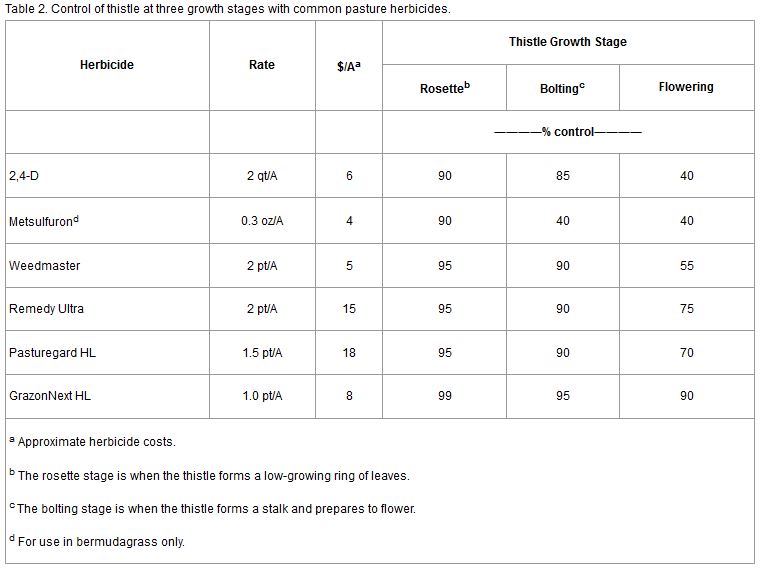It is amazing how much rain we received last weekend in Colquitt County. I have had reports of rainfall amounts from 3.5 to 7 inches of rain in this area and a report or two of small hail. Below is information from Dr. Pam Knox on rainfall amounts from the past week from her blow post “How to document heavy rain events”. Questions about soil fertility and herbicides since the big rain are common from growers. Drs. Glenn Harris and Eric Prostko will hopefully address these questions below. Also information about control thistles is included at the end of this post.

Rain and Fertilizer Applied Prior to the Weekend Rains Harris
Cotton: The good news… I don’t think there is reason to panic…for a number of reasons:
1) Even if you already put out your preplant N-P-K (which is probably most growers)… phosphorous is basically immobile and even though K is mobile it is not as mobile as N.
2) We have time to correct this issue without suffering significant yield reductions.
3) So, the concern is nitrogen…but not all of the N was in the leachable “nitrate form”… (ammonium and urea N is not
susceptible to leaching)
4) And what we got was not what I would call a “leaching rain” i.e. lots of rain over a long period with a chance to soak in and move down through the soil profile. We got what one of my old colleagues would call a “frog strangler” or what I call a “runoff” rain, i.e. where a lot left the field going sideways instead of down.
5) And the official recommendation is to only put out ¼ to 1/3 of your total N at planting – this is designed to get you to sidedressing time and one of the reasons we don’t like to put a larger portion of N out at planting (too much vegetative growth early is another). I already got a call where a grower already put out 2/3 of his total N. News flash – some of that will need to be replaced at some point.
6) But what about potassium? It’s half way to the Gulf of Mexico, too right? I don’t think so. Like I said, it’s not as mobile as N and may have gotten pushed down into the soil profile. But once the cotton tap root gets down deeper (and that probably happens a lot faster than you think) it should still be there.
So…what should you do?
Let’s agree we can take phosphorous off the table and potassium to some extent. I am actually more worried that the “packing rain” we got this weekend will do more to compact soil and limit root growth — and therefore potassium uptake –than I am worried about what K we lost. I wouldn’t look to replace potassium now, but if you already planned to put some more K out I would do it no later than sidedress time (first square to first bloom). Don’t forget we can also foliar feed K once we start blooming if need be.
I also would not be in a huge hurry to replace any nitrogen you think you may have lost, but would simply evaluate what the cotton looks like at first square and be prepared to go with an early N sidedress. Tissue sampling would be amazingly helpful in this regard also. Take a tissue sample sometime right before squaring or at squaring (should be around 35-45 days after planting) to check on N levels. The beauty of this is that we can also check on P and K and everything else – including sulfur!
Sulfur is also highly mobile in soil, like N. so I would recommend including sulfur with your N sidedress. This is pretty easy to do with liquids (like 28-0-0-5(S) and 18-0-0-3(S) and by adding to ammonium sulfate to urea or ammonium sulfate solids. There is also Amidas, urea and ammonium sulfate homogenized into a 40-0-0-5.5(S) granular.
Back to N, if you haven’t planted yet and have the capabilities of putting starter fertilizer in a “2 x 2” (2 inches to the side and 2 inches below the seed), you might consider putting 10 gallons of 10-34-0 in a 2 x 2. Or likely a more economical treatment would be 3-5 gallons of 28-0-0-5(S) in a 2 x 2.
Bottom line…it may not be economical to replace 30 lb N/a right now, especially on large acreage, so be prepared to sidedress N at on the early side of the window (first square rather than first bloom) and maybe bump up the rate 10-25 % then. And tissue sample right before sidedressing if possible.
Corn
If you haven’t finished putting N and S out yet then I would consider replacing about 25 % of your total N rate (include some S too, like with cotton).
If you already had all your N and S out on corn, maybe wait a week and take a tissue sample and see where you stand and if you need to figure out a way to put some more out.
The Big Rain and Herbicides Prostko
Most of Georgia received a significant rainfall event on April 24, 2021 (Figure 1). Some areas received more than 6″. Consequently, my phone has been ringing off the hook about the potential effects of this precipitation event on herbicides. Here are a few thoughts:
1) The two biggest herbicide concerns with heavy rainfall events such as this are runoff and leaching.
2) If a field received enough rainfall to physically move the soil from the field, herbicides were likely moved with it. In this scenario, residual weed control would be reduced. Tough luck here and nobody can prevent/predict an Act of God!!!
3) Herbicide leaching is a complicated interaction of many factors including soil type, OM, and certain chemical properties (i.e. water solubility and soil adsorption). Very generally, herbicides with higher water solubility and lower soil adsorption characteristics are more likely to leach from the soil profile. Check out Table 1 for a list of these properties. Note that dicamba has a very high-water solubility and very low soil adsorption so it is very prone to leaching. Although paraquat and glyphosate are very water soluble, they are strongly adsorbed to soils.
4) Most of the questions that I have been getting have had to do with Prowl (pendimethalin). You will note in Table 1 that Prowl is not very soluble in water and is strongly adsorbed to soils. Thus, it is less likely to leach in comparison to other herbicides so it should still be around in most situations.
5) If a grower has already applied Prowl (on peanut land) and has observed significant soil movement/washing, I would suggest that he/she consider adding an additional 16 oz/A of Prowl in combination with Valor immediately after planting (i.e. behind the press wheel). I would also suggest this in peanut fields where prepared beds must be reworked/remade/ refreshed before planting.


What about controlling thistles???
How can I control thistles? Thistles are biennials, which grow from seed in year one and produce seed in the second year. During the first year, the plant will grow as a rosette and the second year the plant bolts from the rosette stage. Most thistles I see in area pastures are Yellow thistle, also known as horrible thistle (Cirsium horridulum). Yellow thistle has large, clustered flower heads with spiny, feathery bracts that almost enclose each flower’s entire head. Flowers are yellow or reddish purple and rarely white. Stems are covered in fine hairs and hairlike projections.

A single thistle plant can produce at least 4,000 seed so managing the seed bank is important for controlling this pest.
How do I Control it? Mowing can effective if it is timed during late bolting stage of development. The stalk is typically hollow during this time. If you mow thistles during the rosette stage you will be disappointed in the level of control.
Information from University of Florida indicate that good thistle control (>90 %) can be obtain by applying herbicides such as 2,4-D, Metsulfuron, Remedy, Weedmaster, GrazonNext and Pasturegard during the rosette stage of development.

